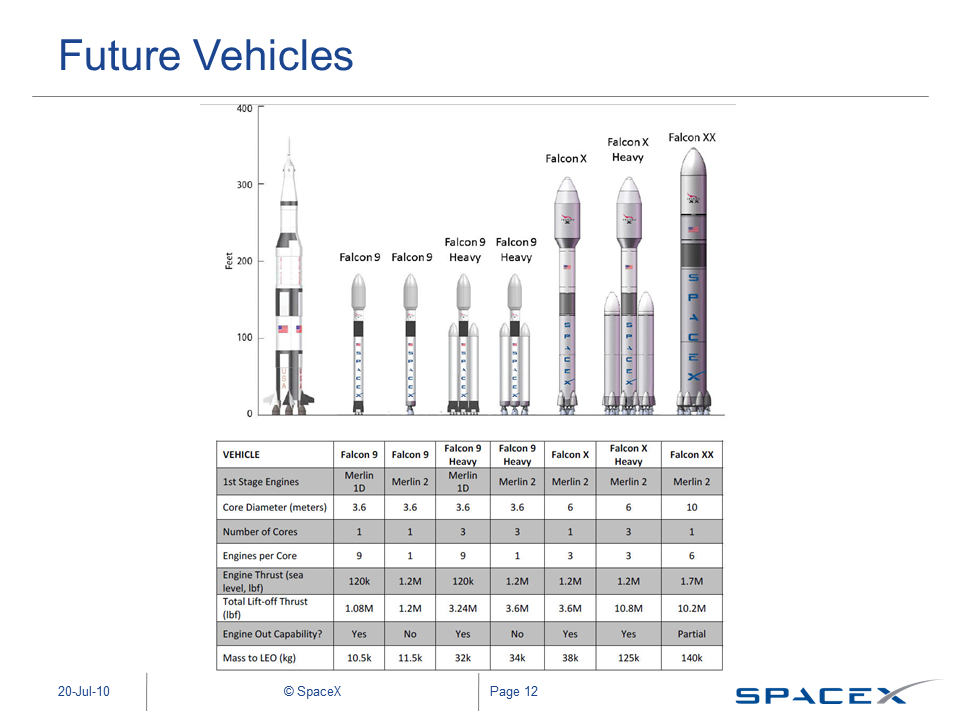Raw thrust in the first stage enables heavier upper stages, and thus heavier payloads into orbit; it also enables greater reliability via lesser enginespam.You seem to only think in terms of raw thrust... there are many other things that might be more important for a given task.
Take a look at the SpaceX Falcon 9 Heavy proposed design.
27(!!!) Merlin 1D Engines to put 32,000 lbs into LEO.
Now; the Defense Department took a look at that and began laughing so hard they couldn't stop; and told SpaceX to stop fucking around with them regarding proposals for space launch services for the DoD.
It's why in a Powerpoint this August, they started to talk about a notational Falcon 9 Heavy Block II with just three "Merlin 2" engines.
Of course, these Merlin 2s are notationally 1.7 million lbf; a massive increase in thrust over Merlin 1.
And of course, on top of this, they're talking about developing a so called "Raptor" upper stage engine...which will of course be Liquid Hydrogen powered.
If you haven't started laughing, you will now.

Nevermind where they are going to get the funding for this from...as you've seen, it cost Rocketdyne $1.7 billion in FY91 dollars to develop the F-1. Adjusted to FY2009 prices, that's $2.64 billion.
Even if we presuppose SpaceX can develop a F-1 class engine for 45% of the cost of the F-1; that still comes out to $1.1 billion USD to develop it. Of course; SpaceX has claimed they can develop it for $1 billion (at the AIAA Joint Propulsion Conference 2010).
Where's SpaceX going to get that money for future development; continue to uprate it's rockets; develop new classes to take advantage of the new Merlin 2; AND develop a high-energy LH2 upper stage?
Because a Saturn V Class vehicle is awesome for unmanned missions.Have there been manned missions to the moon lately? Then why should NASA have build more Saturns V?

Figure is from "Launch Vehicle Performance Capability" in "Mid-Term Technical Progress Report Advanced Planetary Probe Study" circa 15 March 1966 by TRW.
--------------------------------
Saturn V/Centaur injection capabilities:
200 km2/s2 and 10,100 lbs
150 km2/s2 and 15,900~ lbs
100 km2/s2 and 26,800~ lbs
70 km2/s2 and 37,500~ lbs
--------------------
Saturn V (bare) injection capabilities:
169 km2/s2 and 1,900 lbs (Maximum Possible)
150 km2/s2 and 4,900 lbs
100 km2/s2 and 17,300 lbs
70 km2/s2 and 29,800 lbs
---------------------
To put this into context; the NEW HORIZONS mission to Pluto-Charon that was launched a bit ago for a flyby of Pluto required 149 km2/s2 of C3. LINK
New Horizons weighed 1,050 lbs because it had to be launched by an Atlas V 551.
If we still had a Saturn V production line open; then NEW HORIZONS could have weighed 4,900 lbs. If we had added CENTAUR capability to the Saturn V; we could send a 15,900 lb NEW HORIZONS to Pluto.
Either that, or we could have NEW HORIZONS arrive in something less than nine years (launch was 2006, arrival is 2015).
You mean the engine that can only produce 400,000 lbf of thrust at sea level, requiring more of them to be clustered together, operates at 2,700 PSI, and costs $50 million?And while we are at it: the SSME is a far superior engine, its also still in active use.
I fucking laugh at the DIRECT people who seem to think that throwing away a $50 million dollar engine after each flight is a good idea.
Right. Because producing an engine that only produces 125,000 lbf is as technically difficult as producing one that produces 1.8 million lbf at sea level.But thanks for proving that SpaceX is better/more competent now than Rocketdyne was forty years ago...
:rolleyes:
